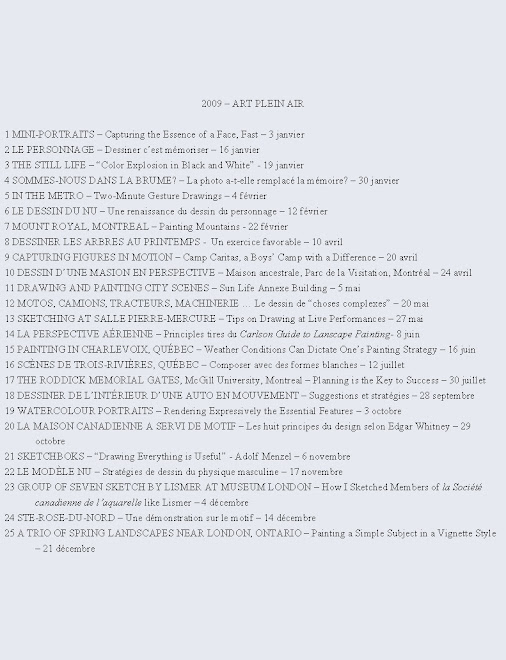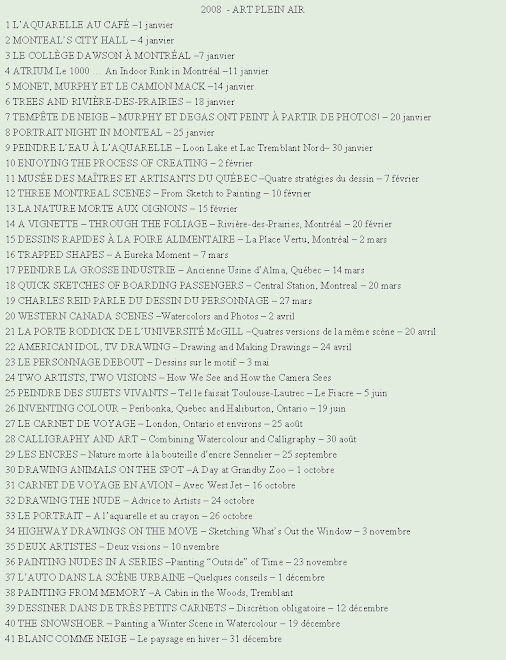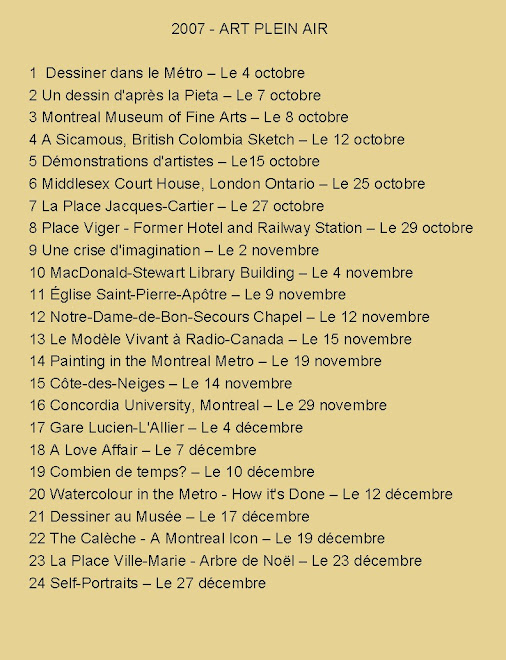The new university started with five Faculties: a merged Faculty of Commerce, merged Faculty of Engineering, a Sir George Williams Faculty of Arts, a SGW Faculty of Science, and a Loyola Faculty of Arts and Science.
 Last Saturday, looking for a place to draw indoors because it was bitter cold outside, my friends and I went into the lobby of the new Engineering, Computer Science and Visual Arts Integrated Complex of the University at Sainte-Catherine and Guy Streets. The lobby of this spacious indoor venue, which opened in September 2005, is well furnished with tables and chairs. This gave us the opportunity to draw people indoors and outdoors.
Last Saturday, looking for a place to draw indoors because it was bitter cold outside, my friends and I went into the lobby of the new Engineering, Computer Science and Visual Arts Integrated Complex of the University at Sainte-Catherine and Guy Streets. The lobby of this spacious indoor venue, which opened in September 2005, is well furnished with tables and chairs. This gave us the opportunity to draw people indoors and outdoors. Looking out the window of the lobby I drew the first of two versions of a view looking westward along Ste-Catherine. I worked in my sketch book and used an archival ink pen, reservoir brush and pan colors. A few days later I returned and painted another study (the second illustration). This time I painted on Cartiera Magnani cold press watercolor paper in pad form (7 x 10 inches). I used both of my pocket paint brushes, the Isabey 6202 and the Kolinsky Connosisseur 405-7 flat, both brushes are available at Art Tec. I also took a few photos of the scene, one of which is posted above. All this information will be enough for me to do a larger watercolor in studio.
Looking out the window of the lobby I drew the first of two versions of a view looking westward along Ste-Catherine. I worked in my sketch book and used an archival ink pen, reservoir brush and pan colors. A few days later I returned and painted another study (the second illustration). This time I painted on Cartiera Magnani cold press watercolor paper in pad form (7 x 10 inches). I used both of my pocket paint brushes, the Isabey 6202 and the Kolinsky Connosisseur 405-7 flat, both brushes are available at Art Tec. I also took a few photos of the scene, one of which is posted above. All this information will be enough for me to do a larger watercolor in studio.  Regarding the black and white pencil (graphite) sketches illustrated here: These were done of passers-by walking on Sainte-Catherine Street. The strategy I used is as follows: I visually memorized a profile as the person walked by. Then I quickly sketched it before the information faded. I repeated the procedure once again but this time I added information to the original sketch from another person such as the hair or an arm holding a bag. The resulting drawing of one individual is really a composite of a few people walking in front of me. In order to succeed I had to really concentrate and jot down just the essential elements of a profile or a movement. Most people were really walking fast. Essentially this exercise enticed me to draw and invent what I wanted to see. A very good book this topic is Charles Reid’s book: Painting What you - want to – See.
Regarding the black and white pencil (graphite) sketches illustrated here: These were done of passers-by walking on Sainte-Catherine Street. The strategy I used is as follows: I visually memorized a profile as the person walked by. Then I quickly sketched it before the information faded. I repeated the procedure once again but this time I added information to the original sketch from another person such as the hair or an arm holding a bag. The resulting drawing of one individual is really a composite of a few people walking in front of me. In order to succeed I had to really concentrate and jot down just the essential elements of a profile or a movement. Most people were really walking fast. Essentially this exercise enticed me to draw and invent what I wanted to see. A very good book this topic is Charles Reid’s book: Painting What you - want to – See.  I also realized while doing this exercise that as the light faded and the contrasts became less distinct it became more difficult to decipher the forms correctly. Generally it is much easier to draw a subject well illuminated from a light source. If you are interested in painting motion consult the book How to Capture Movement in your paintings by Julia Cassels.
I also realized while doing this exercise that as the light faded and the contrasts became less distinct it became more difficult to decipher the forms correctly. Generally it is much easier to draw a subject well illuminated from a light source. If you are interested in painting motion consult the book How to Capture Movement in your paintings by Julia Cassels. One must never forget, however, that just reading books won’t make one a better artist. To improve one has to practice and do art. And as far as improving drawing skills – the basis of all art – nothing is better, I feel, than drawing/painting from life.
One must never forget, however, that just reading books won’t make one a better artist. To improve one has to practice and do art. And as far as improving drawing skills – the basis of all art – nothing is better, I feel, than drawing/painting from life. Raynald Murphy sca
Raynald Murphy sca
 Raynald Murphy sca
Raynald Murphy sca







 Pourquoi dessiner le nu? Premièrement, l’histoire de l’art nous enseigne que lors de l’époque classique l’artiste qui voulait s’améliorer faisait du dessin du nu. Ça faisait parti du système d’apprentissage. Au 21e siècle chacun le fait pour divers raisons. Peter Steinhart dans son livre
Pourquoi dessiner le nu? Premièrement, l’histoire de l’art nous enseigne que lors de l’époque classique l’artiste qui voulait s’améliorer faisait du dessin du nu. Ça faisait parti du système d’apprentissage. Au 21e siècle chacun le fait pour divers raisons. Peter Steinhart dans son livre  This historic chapel has been painted so many times by artists over the years from this view that I had promised myself never to paint it from this angle. But, as you can see, I came upon this enticing dramatic light one day and returned soon after to paint it. Truthfully, the watercolor you see was done in three stages. One cold Sunday afternoon I sat before the scene and sketched it on a sheet of Stratmore Aquarius II paper with a permanent felt pen. The near zero temperature prevented me from adding color which would not have dried anyway. So I returned another day to paint it. However, the cold once again forced me to abandon, this time because my fingers were freezing. I therefore completed the green tower and a few other sections in studio.
This historic chapel has been painted so many times by artists over the years from this view that I had promised myself never to paint it from this angle. But, as you can see, I came upon this enticing dramatic light one day and returned soon after to paint it. Truthfully, the watercolor you see was done in three stages. One cold Sunday afternoon I sat before the scene and sketched it on a sheet of Stratmore Aquarius II paper with a permanent felt pen. The near zero temperature prevented me from adding color which would not have dried anyway. So I returned another day to paint it. However, the cold once again forced me to abandon, this time because my fingers were freezing. I therefore completed the green tower and a few other sections in studio.













